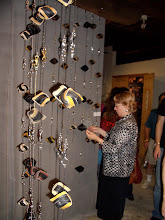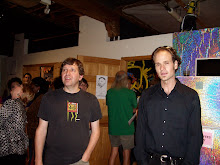The Installation of Three Knots, Two Spheres, and a Mirror
RECLAMATION @ Hermitage Museum & Gardens
Location: The Hermitage Museum Hallway, downstairs
Another space that the museum generously offered me to use was a long hall in the Museum downstairs itself! What is especially special about this hall, is that it ends with a set of large windows, and a spectacular view of the Lafeyette River, which passes before the Museum, on its way out to the Sea…sigh.
And in front of this window, Melanie and Melissa (known henceforth as M & M) wanted to put my sculptures!
I had some delusions about this piece, I must admit.
I wanted to make a giant panel, to reference one of 3 exquisite friezes carved into panels along this wall, by the window, I am guessing by Rydingspar. And while I had been thinking to do this all in rubber, Museum Director and Art History Professor, Melanie Mathews, saw an even richer possibility. To build the thing on Plexiglass, and allow the light to shine through, like a true piece of gothic tire art should! But alas, as much as I would have loved to, I didn’t think I could pull this one off in the time I had left, so I had to let it go…
I hope someday, I’ll find a second chance..
But I was able to hang Rydingspar’s tiresphere in the adjacent window, beneath those very carvings, paying some tribute his gothic sensibilities shown above…
And this view / picture window view also became the glowing halo around the gargantuan knot, “Leviathan”, who made a return guest appearance (from Spiritual Visions 2010) and took this place of honor for the exhibition. (which seemed fitting to M & M, as they shared that Leviathan had infact been the spring board for bringing Ed and I together to make this show “Reclamation”.
The siting of the large knot, before this large, laced window, turned out to be a stunning combo, as M & M insisted that he be tilted up, as they done in Spiritual Visions (leaning him against the wall). With no wall to lean against here, this was to be an installation challenge. But, thankfully they relieved me of this duty, and Tom rose to the challenge, deftly employing a couple of black wedges behind him. The result was that L stood there (I would say majesticly( before the window, radiating his powerful, and stately presence, while the light from the window shown through his center, which itself became another window. A true leader, that one. And a brilliant use of this sculpture, I have to hand it to them.
Leading up to Leviathan were two smaller knots, creating a series of three sort of visual stepping stones. I felt that this was really important, and I begged and scraped and pleaded endlessly for permission to do this. (this was only the second time that they had allowed a new artist’s work in the museum itself). To me, the series of three was very important, for several reasons. For one, well, I’m big on threes, they just come up over and over again in my work.
Of course, there is the association of the holy trinity, which HAS found its place in Hermitage’s artistry. You know, when you have a series of three, something magical happens, because you have a story; a beginning, and middle, and an end. For people to be led down this path, with a glorious destination awaiting them, just seemed like too great of an opportunity to be missed, especially in a place with such spiritual underpinnings.
And this series was in good company. The first of these knots landed smack in front of a stone Bhudda statue from the ??? century, flanked by two large, impressive, ornate, turquoise gourd-like ceramic vessels, one on each side! (I'm not allowed to publish photo's of this on the web, unfortunately).
This knot, I called “Norfolk Knot”, and was sort of my tribute to the sea, or waterway, which is a central part of Norfolk’s history.
To bring this marine element in, I used a really delicate and graceful strand of pillow trim that I had culled from the Scrap Exchange, bearing a lot of cool, aquatic tones. This I wrapped along the edge of a tredknot with its own strange history (it was once stolen from my car and later recovered…good story here, ask me sometime).
After some puzzling and reconfiguring, I was able to lay this along this edge in such a way that the lip of the tire’s edge, which I always strain to leave intact, acted as sort of a border or ledge, holding this ribbon in place (I never did need to glue the ribbon down, it just rested, nestled in place).
Visually, this provided a linier black edge, which made a strong visual impact, particularly as the three facets of the tire and ribbon converged at the knots center. The effect I find to be stunning, and I consider Norfolk Knot to be one of the finer specimens in the show.
And of course, to present this knotted tire, with its band winding around itself, in a symbol of continuity and regeneration, before this silent, ancient statue of Sidharta, was, well, a little bit mind blowing….
Next up we had “Queen’s Squire Knot”, which is another tribute to Charles Woodsend, the chief builder and sculptor of the house.
For this piece, I used a knot that I had built previously, from a farm implement tire with a very peculiar tread. I’m not sure what the repeating shape is called, but it has always had the feel of some medieval crest. Very Middle Ages, this knot. To enhance this aspect, I had added a pillow trim whose various faire colored strands looked like they had been pulled straight from a medieval tapestry.
And indeed, this piece found its own perfect place in this hall, landing in between Norfolk Knot, and Leviathan, smack in front of a particular painting that Mrs. Sloane had commissioned while in Europe, showing a mideval scene of Charles Woodsend, in his frock clothe, carving away at some frieze or other, as Mrs. Sloane in her gown and Guenivere Princess hat, and her children, looked on approvingly. It is actually a really nice painting, and the colors in the painting are reflected perfectly by the colors in the knot. (unfortunately, I am not allowed to show an image of this on the internet).
Also, back up the hall on the same side, about 10 paces up, is a display of a medieval tapestry using an old technique called ‘stump work’, in which the artist uses a carved block of wood to act as an under-form onto which they model the tapestries bas-relief features.
So point being, I feel that these three knots really found their perfect place, interacting with and reflecting various aspects of the house, its history, the permanent collection, and the environment surrounding the Sloane’s house.
To this end, with M & M’s good help, we also found a great place in this hall for a mirror that I had recently concocted for the Festival for the Eno- “Tar Pit Mirror”, featuring a poster of fossilized trees, a roofing tar inlay, and a ‘Tyranosaurus’ hybrid mountain bike tire.
As you can see, the creamy yellow tones of the mirror’s main surface matched the color of the walls in this hall perfectly, as did the browns match the hues of the particular wooden wall it was mounted on. And what’s more, they found me a spot to hang it above a couch, where the half circles carved in the head board above really harmonize with the circular mirror nicely.
Art History Professor, Virginia, who adopted Queen’s Squire Knot on the night of the opening, told me later that she thought the piece fit so well there, that they should keep it there! I’ll second that!
My hat is off to M & M for this excellent placement.
So, in summary it was really both an honor and a thrill to have the chance to show these pieces downstairs in the museum like this. Of course, there is the ego excitement of showing my tire artworks in a museum, which is substantial. But moreover, what artist wouldn’t get off on being allowed to bring their artwork into a museum, and place the thing near an old masterpiece, sitting there in the corner, maybe looking a little bored and drowsy. What parent (of an artwork) wouldn’t love to introduce their children to a wisened, wrinkly old senior at a party, with a spark in their eye, and watch the interactions that ensue?
To watch these two generations light up in one another’s presence.
Mission Accomplished.
















